Orientation Package: New Health Worker Guide for Cure with Care
VerifiedAdded on 2020/05/08
|11
|2970
|104
Report
AI Summary
This report presents an orientation package developed for new health workers and managers within 'Cure with Care,' a community-controlled health organization focused on Indigenous health in Australia and New Zealand. The package includes a comprehensive introduction to the organization's background, history, and community profile, emphasizing its commitment to addressing the health disparities faced by Indigenous populations. It outlines the organization's mission, values, and the health issues prevalent within the community, such as cancer, heart disease, diabetes, and mental health concerns. The report also defines the roles of key stakeholders, both internal and external, and provides detailed guidelines and protocols for healthcare practices, including quality control, ethical consent, record-keeping, handwashing techniques, and waste disposal. Furthermore, it addresses the challenges and strategies for working cross-culturally, offering a toolkit of resources and outlining the rights and responsibilities of community health workers. The report concludes with information on contacts, entitlements, and conditions, ensuring a clear understanding of the organization's operations and employee expectations.
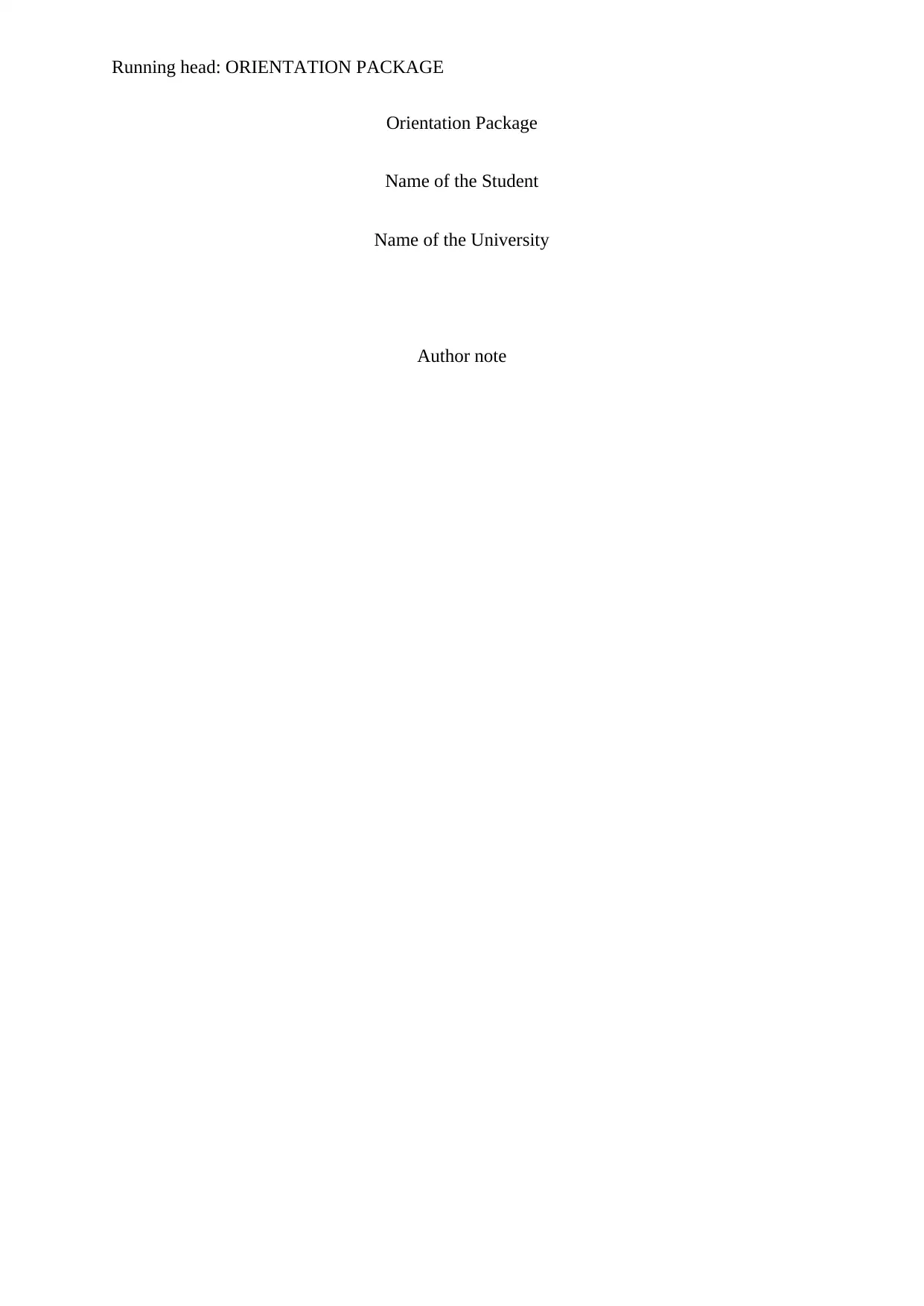
Running head: ORIENTATION PACKAGE
Orientation Package
Name of the Student
Name of the University
Author note
Orientation Package
Name of the Student
Name of the University
Author note
Paraphrase This Document
Need a fresh take? Get an instant paraphrase of this document with our AI Paraphraser
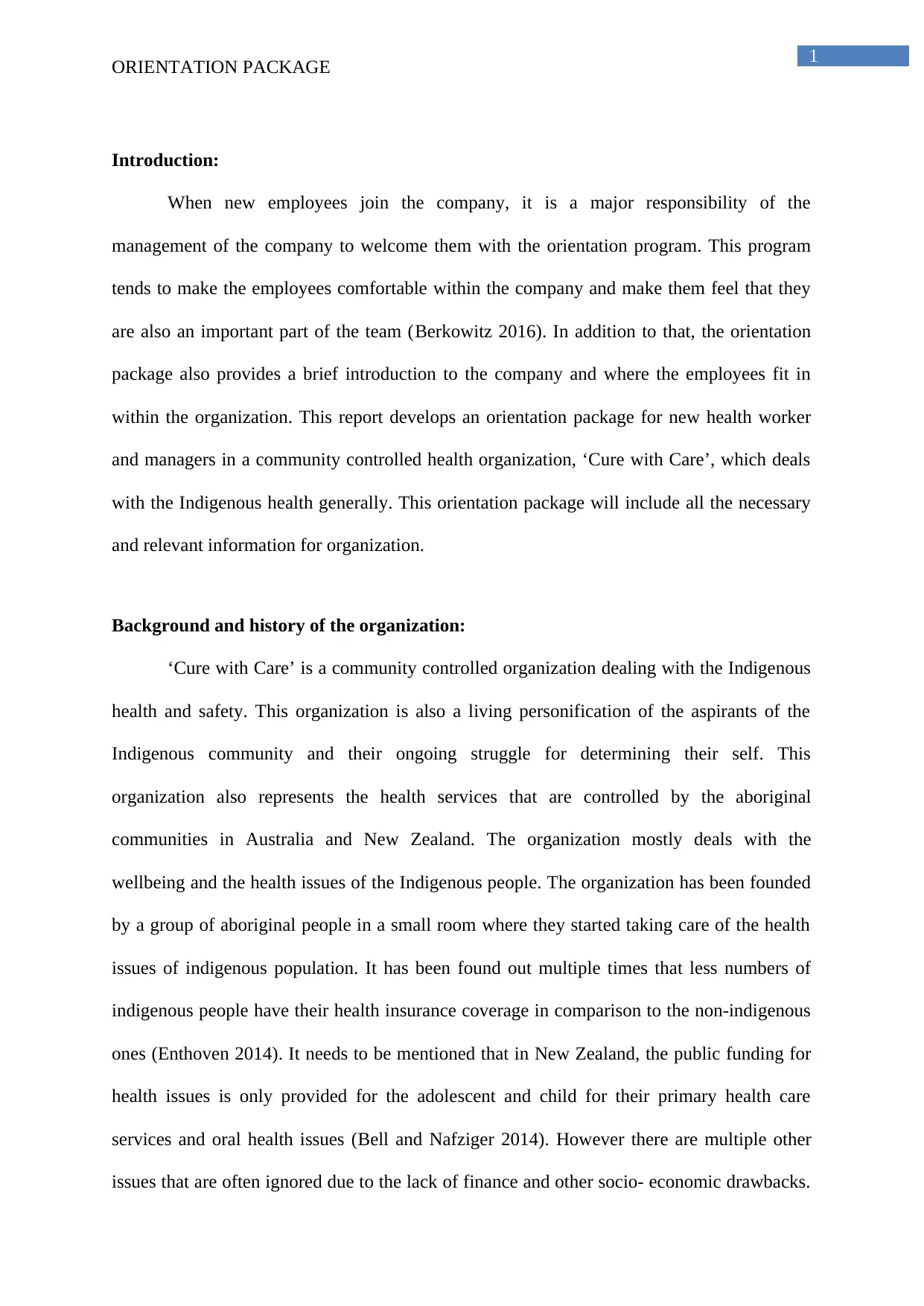
1
ORIENTATION PACKAGE
Introduction:
When new employees join the company, it is a major responsibility of the
management of the company to welcome them with the orientation program. This program
tends to make the employees comfortable within the company and make them feel that they
are also an important part of the team (Berkowitz 2016). In addition to that, the orientation
package also provides a brief introduction to the company and where the employees fit in
within the organization. This report develops an orientation package for new health worker
and managers in a community controlled health organization, ‘Cure with Care’, which deals
with the Indigenous health generally. This orientation package will include all the necessary
and relevant information for organization.
Background and history of the organization:
‘Cure with Care’ is a community controlled organization dealing with the Indigenous
health and safety. This organization is also a living personification of the aspirants of the
Indigenous community and their ongoing struggle for determining their self. This
organization also represents the health services that are controlled by the aboriginal
communities in Australia and New Zealand. The organization mostly deals with the
wellbeing and the health issues of the Indigenous people. The organization has been founded
by a group of aboriginal people in a small room where they started taking care of the health
issues of indigenous population. It has been found out multiple times that less numbers of
indigenous people have their health insurance coverage in comparison to the non-indigenous
ones (Enthoven 2014). It needs to be mentioned that in New Zealand, the public funding for
health issues is only provided for the adolescent and child for their primary health care
services and oral health issues (Bell and Nafziger 2014). However there are multiple other
issues that are often ignored due to the lack of finance and other socio- economic drawbacks.
ORIENTATION PACKAGE
Introduction:
When new employees join the company, it is a major responsibility of the
management of the company to welcome them with the orientation program. This program
tends to make the employees comfortable within the company and make them feel that they
are also an important part of the team (Berkowitz 2016). In addition to that, the orientation
package also provides a brief introduction to the company and where the employees fit in
within the organization. This report develops an orientation package for new health worker
and managers in a community controlled health organization, ‘Cure with Care’, which deals
with the Indigenous health generally. This orientation package will include all the necessary
and relevant information for organization.
Background and history of the organization:
‘Cure with Care’ is a community controlled organization dealing with the Indigenous
health and safety. This organization is also a living personification of the aspirants of the
Indigenous community and their ongoing struggle for determining their self. This
organization also represents the health services that are controlled by the aboriginal
communities in Australia and New Zealand. The organization mostly deals with the
wellbeing and the health issues of the Indigenous people. The organization has been founded
by a group of aboriginal people in a small room where they started taking care of the health
issues of indigenous population. It has been found out multiple times that less numbers of
indigenous people have their health insurance coverage in comparison to the non-indigenous
ones (Enthoven 2014). It needs to be mentioned that in New Zealand, the public funding for
health issues is only provided for the adolescent and child for their primary health care
services and oral health issues (Bell and Nafziger 2014). However there are multiple other
issues that are often ignored due to the lack of finance and other socio- economic drawbacks.
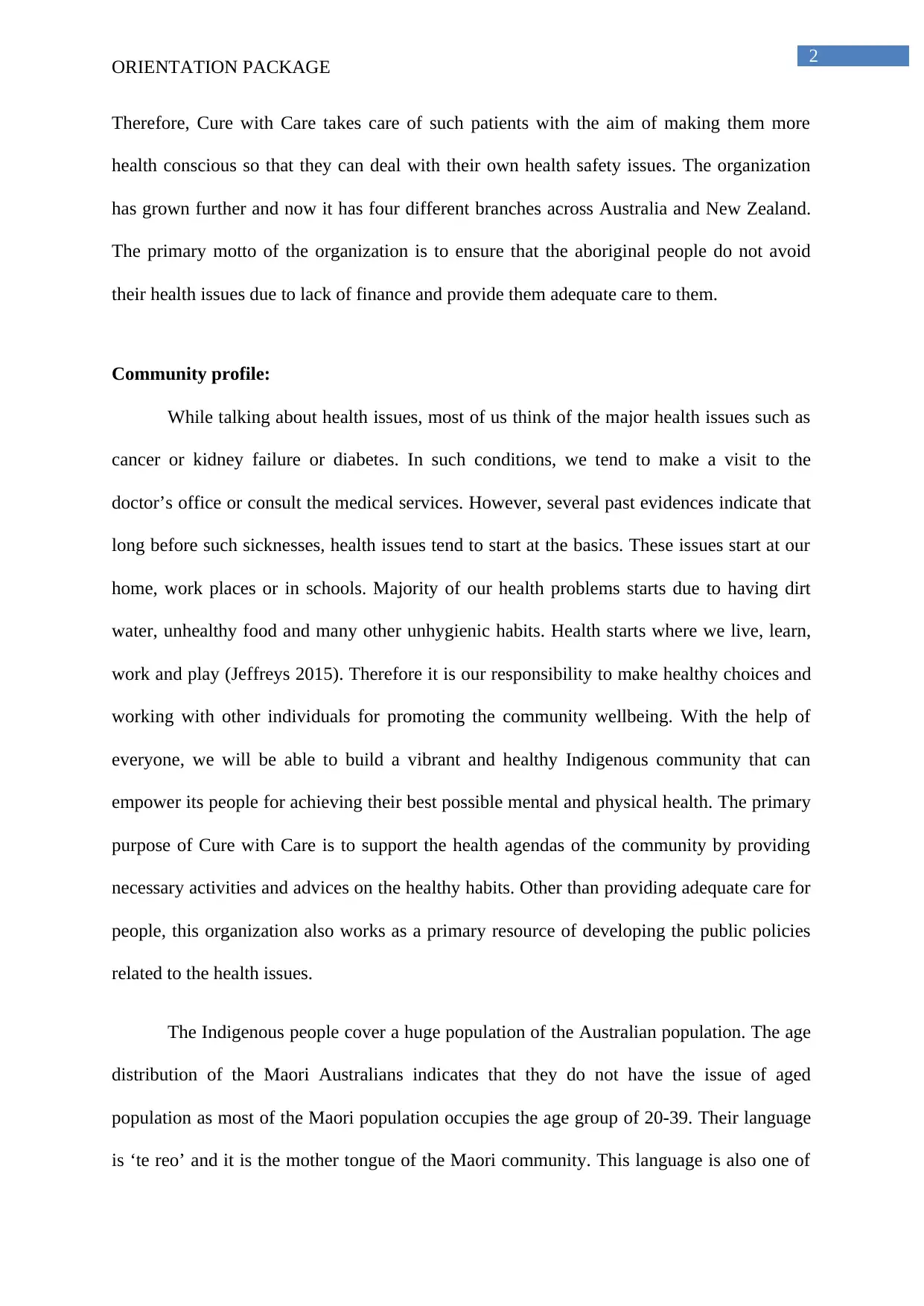
2
ORIENTATION PACKAGE
Therefore, Cure with Care takes care of such patients with the aim of making them more
health conscious so that they can deal with their own health safety issues. The organization
has grown further and now it has four different branches across Australia and New Zealand.
The primary motto of the organization is to ensure that the aboriginal people do not avoid
their health issues due to lack of finance and provide them adequate care to them.
Community profile:
While talking about health issues, most of us think of the major health issues such as
cancer or kidney failure or diabetes. In such conditions, we tend to make a visit to the
doctor’s office or consult the medical services. However, several past evidences indicate that
long before such sicknesses, health issues tend to start at the basics. These issues start at our
home, work places or in schools. Majority of our health problems starts due to having dirt
water, unhealthy food and many other unhygienic habits. Health starts where we live, learn,
work and play (Jeffreys 2015). Therefore it is our responsibility to make healthy choices and
working with other individuals for promoting the community wellbeing. With the help of
everyone, we will be able to build a vibrant and healthy Indigenous community that can
empower its people for achieving their best possible mental and physical health. The primary
purpose of Cure with Care is to support the health agendas of the community by providing
necessary activities and advices on the healthy habits. Other than providing adequate care for
people, this organization also works as a primary resource of developing the public policies
related to the health issues.
The Indigenous people cover a huge population of the Australian population. The age
distribution of the Maori Australians indicates that they do not have the issue of aged
population as most of the Maori population occupies the age group of 20-39. Their language
is ‘te reo’ and it is the mother tongue of the Maori community. This language is also one of
ORIENTATION PACKAGE
Therefore, Cure with Care takes care of such patients with the aim of making them more
health conscious so that they can deal with their own health safety issues. The organization
has grown further and now it has four different branches across Australia and New Zealand.
The primary motto of the organization is to ensure that the aboriginal people do not avoid
their health issues due to lack of finance and provide them adequate care to them.
Community profile:
While talking about health issues, most of us think of the major health issues such as
cancer or kidney failure or diabetes. In such conditions, we tend to make a visit to the
doctor’s office or consult the medical services. However, several past evidences indicate that
long before such sicknesses, health issues tend to start at the basics. These issues start at our
home, work places or in schools. Majority of our health problems starts due to having dirt
water, unhealthy food and many other unhygienic habits. Health starts where we live, learn,
work and play (Jeffreys 2015). Therefore it is our responsibility to make healthy choices and
working with other individuals for promoting the community wellbeing. With the help of
everyone, we will be able to build a vibrant and healthy Indigenous community that can
empower its people for achieving their best possible mental and physical health. The primary
purpose of Cure with Care is to support the health agendas of the community by providing
necessary activities and advices on the healthy habits. Other than providing adequate care for
people, this organization also works as a primary resource of developing the public policies
related to the health issues.
The Indigenous people cover a huge population of the Australian population. The age
distribution of the Maori Australians indicates that they do not have the issue of aged
population as most of the Maori population occupies the age group of 20-39. Their language
is ‘te reo’ and it is the mother tongue of the Maori community. This language is also one of
⊘ This is a preview!⊘
Do you want full access?
Subscribe today to unlock all pages.

Trusted by 1+ million students worldwide
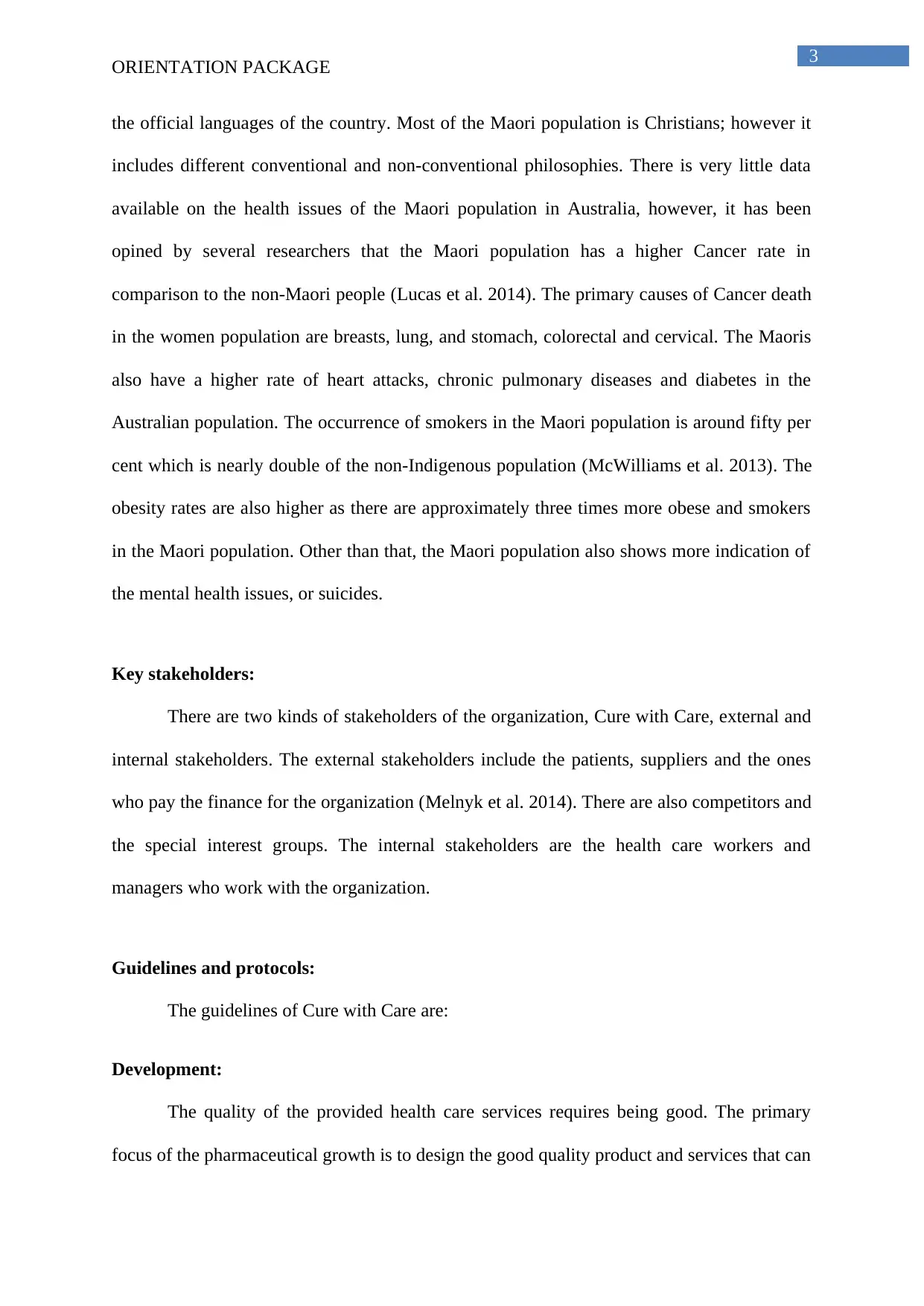
3
ORIENTATION PACKAGE
the official languages of the country. Most of the Maori population is Christians; however it
includes different conventional and non-conventional philosophies. There is very little data
available on the health issues of the Maori population in Australia, however, it has been
opined by several researchers that the Maori population has a higher Cancer rate in
comparison to the non-Maori people (Lucas et al. 2014). The primary causes of Cancer death
in the women population are breasts, lung, and stomach, colorectal and cervical. The Maoris
also have a higher rate of heart attacks, chronic pulmonary diseases and diabetes in the
Australian population. The occurrence of smokers in the Maori population is around fifty per
cent which is nearly double of the non-Indigenous population (McWilliams et al. 2013). The
obesity rates are also higher as there are approximately three times more obese and smokers
in the Maori population. Other than that, the Maori population also shows more indication of
the mental health issues, or suicides.
Key stakeholders:
There are two kinds of stakeholders of the organization, Cure with Care, external and
internal stakeholders. The external stakeholders include the patients, suppliers and the ones
who pay the finance for the organization (Melnyk et al. 2014). There are also competitors and
the special interest groups. The internal stakeholders are the health care workers and
managers who work with the organization.
Guidelines and protocols:
The guidelines of Cure with Care are:
Development:
The quality of the provided health care services requires being good. The primary
focus of the pharmaceutical growth is to design the good quality product and services that can
ORIENTATION PACKAGE
the official languages of the country. Most of the Maori population is Christians; however it
includes different conventional and non-conventional philosophies. There is very little data
available on the health issues of the Maori population in Australia, however, it has been
opined by several researchers that the Maori population has a higher Cancer rate in
comparison to the non-Maori people (Lucas et al. 2014). The primary causes of Cancer death
in the women population are breasts, lung, and stomach, colorectal and cervical. The Maoris
also have a higher rate of heart attacks, chronic pulmonary diseases and diabetes in the
Australian population. The occurrence of smokers in the Maori population is around fifty per
cent which is nearly double of the non-Indigenous population (McWilliams et al. 2013). The
obesity rates are also higher as there are approximately three times more obese and smokers
in the Maori population. Other than that, the Maori population also shows more indication of
the mental health issues, or suicides.
Key stakeholders:
There are two kinds of stakeholders of the organization, Cure with Care, external and
internal stakeholders. The external stakeholders include the patients, suppliers and the ones
who pay the finance for the organization (Melnyk et al. 2014). There are also competitors and
the special interest groups. The internal stakeholders are the health care workers and
managers who work with the organization.
Guidelines and protocols:
The guidelines of Cure with Care are:
Development:
The quality of the provided health care services requires being good. The primary
focus of the pharmaceutical growth is to design the good quality product and services that can
Paraphrase This Document
Need a fresh take? Get an instant paraphrase of this document with our AI Paraphraser
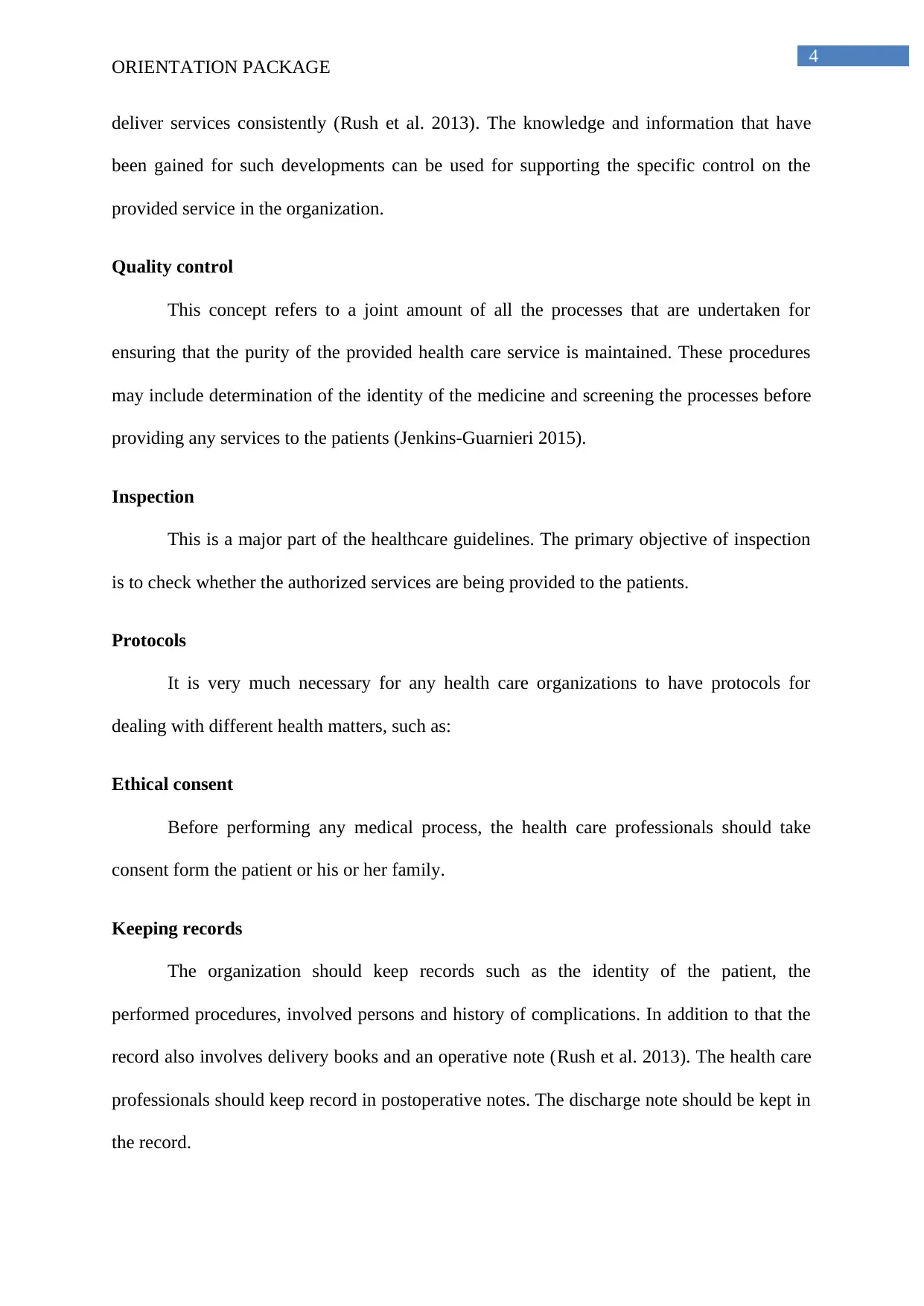
4
ORIENTATION PACKAGE
deliver services consistently (Rush et al. 2013). The knowledge and information that have
been gained for such developments can be used for supporting the specific control on the
provided service in the organization.
Quality control
This concept refers to a joint amount of all the processes that are undertaken for
ensuring that the purity of the provided health care service is maintained. These procedures
may include determination of the identity of the medicine and screening the processes before
providing any services to the patients (Jenkins-Guarnieri 2015).
Inspection
This is a major part of the healthcare guidelines. The primary objective of inspection
is to check whether the authorized services are being provided to the patients.
Protocols
It is very much necessary for any health care organizations to have protocols for
dealing with different health matters, such as:
Ethical consent
Before performing any medical process, the health care professionals should take
consent form the patient or his or her family.
Keeping records
The organization should keep records such as the identity of the patient, the
performed procedures, involved persons and history of complications. In addition to that the
record also involves delivery books and an operative note (Rush et al. 2013). The health care
professionals should keep record in postoperative notes. The discharge note should be kept in
the record.
ORIENTATION PACKAGE
deliver services consistently (Rush et al. 2013). The knowledge and information that have
been gained for such developments can be used for supporting the specific control on the
provided service in the organization.
Quality control
This concept refers to a joint amount of all the processes that are undertaken for
ensuring that the purity of the provided health care service is maintained. These procedures
may include determination of the identity of the medicine and screening the processes before
providing any services to the patients (Jenkins-Guarnieri 2015).
Inspection
This is a major part of the healthcare guidelines. The primary objective of inspection
is to check whether the authorized services are being provided to the patients.
Protocols
It is very much necessary for any health care organizations to have protocols for
dealing with different health matters, such as:
Ethical consent
Before performing any medical process, the health care professionals should take
consent form the patient or his or her family.
Keeping records
The organization should keep records such as the identity of the patient, the
performed procedures, involved persons and history of complications. In addition to that the
record also involves delivery books and an operative note (Rush et al. 2013). The health care
professionals should keep record in postoperative notes. The discharge note should be kept in
the record.
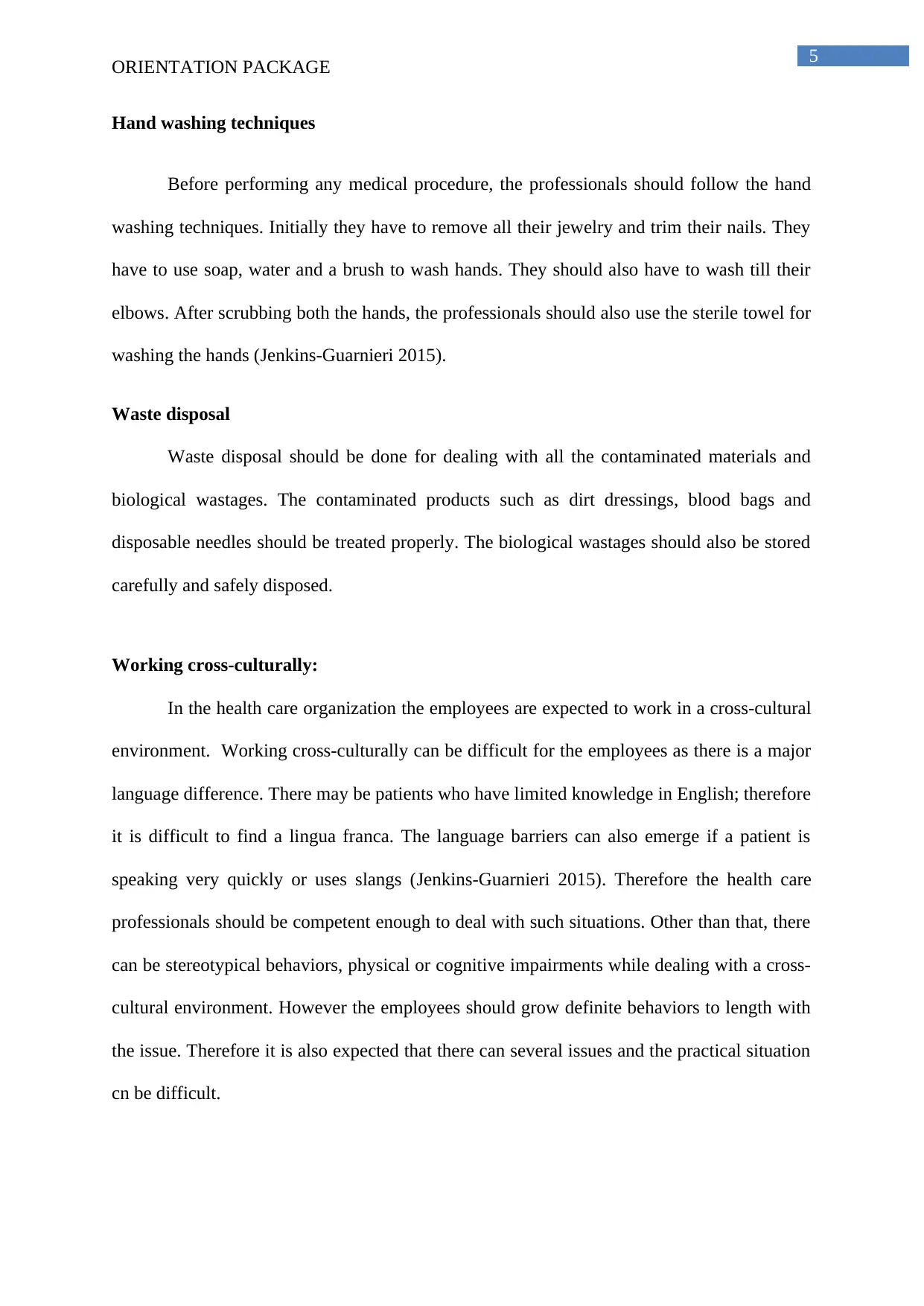
5
ORIENTATION PACKAGE
Hand washing techniques
Before performing any medical procedure, the professionals should follow the hand
washing techniques. Initially they have to remove all their jewelry and trim their nails. They
have to use soap, water and a brush to wash hands. They should also have to wash till their
elbows. After scrubbing both the hands, the professionals should also use the sterile towel for
washing the hands (Jenkins-Guarnieri 2015).
Waste disposal
Waste disposal should be done for dealing with all the contaminated materials and
biological wastages. The contaminated products such as dirt dressings, blood bags and
disposable needles should be treated properly. The biological wastages should also be stored
carefully and safely disposed.
Working cross-culturally:
In the health care organization the employees are expected to work in a cross-cultural
environment. Working cross-culturally can be difficult for the employees as there is a major
language difference. There may be patients who have limited knowledge in English; therefore
it is difficult to find a lingua franca. The language barriers can also emerge if a patient is
speaking very quickly or uses slangs (Jenkins-Guarnieri 2015). Therefore the health care
professionals should be competent enough to deal with such situations. Other than that, there
can be stereotypical behaviors, physical or cognitive impairments while dealing with a cross-
cultural environment. However the employees should grow definite behaviors to length with
the issue. Therefore it is also expected that there can several issues and the practical situation
cn be difficult.
ORIENTATION PACKAGE
Hand washing techniques
Before performing any medical procedure, the professionals should follow the hand
washing techniques. Initially they have to remove all their jewelry and trim their nails. They
have to use soap, water and a brush to wash hands. They should also have to wash till their
elbows. After scrubbing both the hands, the professionals should also use the sterile towel for
washing the hands (Jenkins-Guarnieri 2015).
Waste disposal
Waste disposal should be done for dealing with all the contaminated materials and
biological wastages. The contaminated products such as dirt dressings, blood bags and
disposable needles should be treated properly. The biological wastages should also be stored
carefully and safely disposed.
Working cross-culturally:
In the health care organization the employees are expected to work in a cross-cultural
environment. Working cross-culturally can be difficult for the employees as there is a major
language difference. There may be patients who have limited knowledge in English; therefore
it is difficult to find a lingua franca. The language barriers can also emerge if a patient is
speaking very quickly or uses slangs (Jenkins-Guarnieri 2015). Therefore the health care
professionals should be competent enough to deal with such situations. Other than that, there
can be stereotypical behaviors, physical or cognitive impairments while dealing with a cross-
cultural environment. However the employees should grow definite behaviors to length with
the issue. Therefore it is also expected that there can several issues and the practical situation
cn be difficult.
⊘ This is a preview!⊘
Do you want full access?
Subscribe today to unlock all pages.

Trusted by 1+ million students worldwide
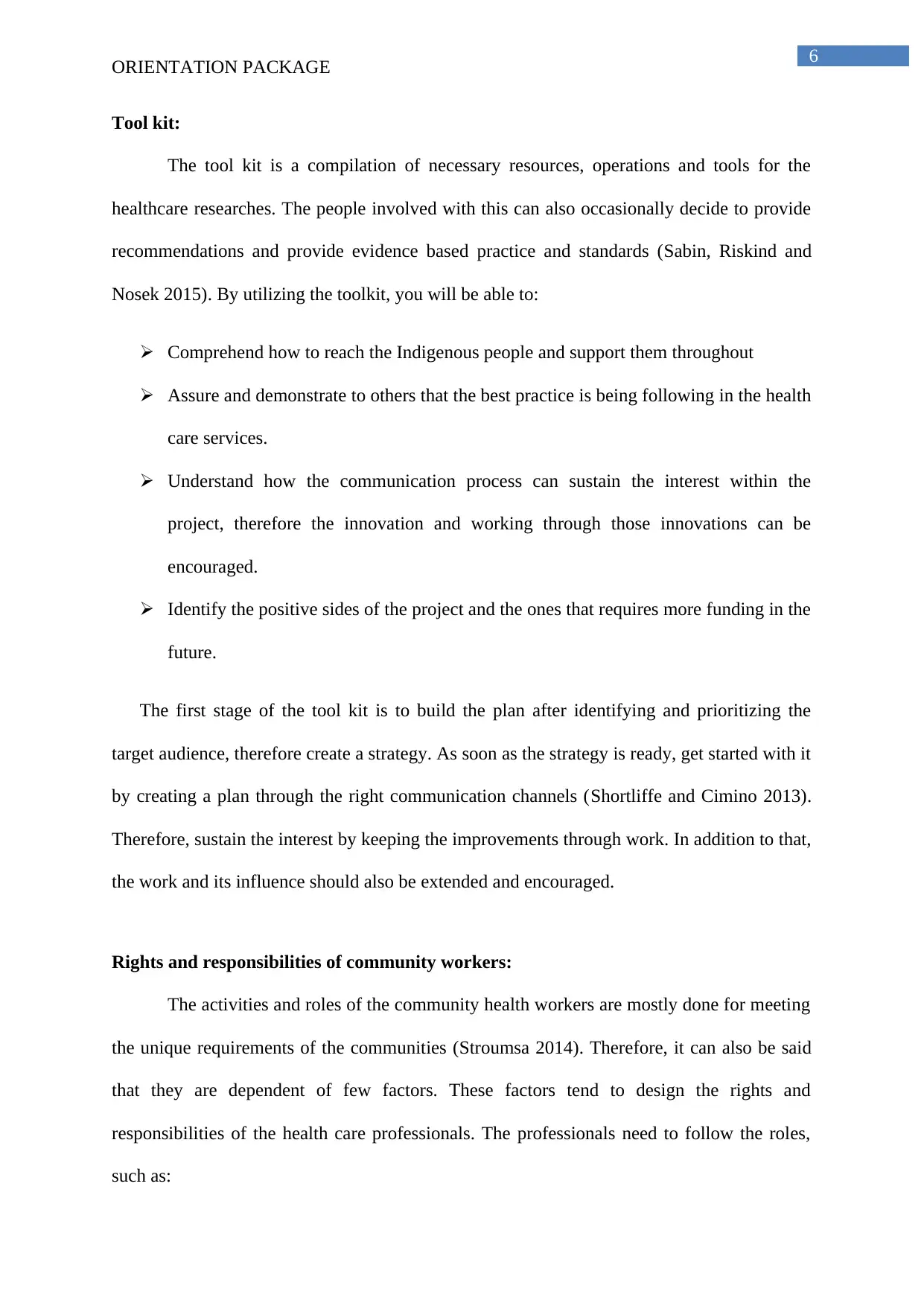
6
ORIENTATION PACKAGE
Tool kit:
The tool kit is a compilation of necessary resources, operations and tools for the
healthcare researches. The people involved with this can also occasionally decide to provide
recommendations and provide evidence based practice and standards (Sabin, Riskind and
Nosek 2015). By utilizing the toolkit, you will be able to:
Comprehend how to reach the Indigenous people and support them throughout
Assure and demonstrate to others that the best practice is being following in the health
care services.
Understand how the communication process can sustain the interest within the
project, therefore the innovation and working through those innovations can be
encouraged.
Identify the positive sides of the project and the ones that requires more funding in the
future.
The first stage of the tool kit is to build the plan after identifying and prioritizing the
target audience, therefore create a strategy. As soon as the strategy is ready, get started with it
by creating a plan through the right communication channels (Shortliffe and Cimino 2013).
Therefore, sustain the interest by keeping the improvements through work. In addition to that,
the work and its influence should also be extended and encouraged.
Rights and responsibilities of community workers:
The activities and roles of the community health workers are mostly done for meeting
the unique requirements of the communities (Stroumsa 2014). Therefore, it can also be said
that they are dependent of few factors. These factors tend to design the rights and
responsibilities of the health care professionals. The professionals need to follow the roles,
such as:
ORIENTATION PACKAGE
Tool kit:
The tool kit is a compilation of necessary resources, operations and tools for the
healthcare researches. The people involved with this can also occasionally decide to provide
recommendations and provide evidence based practice and standards (Sabin, Riskind and
Nosek 2015). By utilizing the toolkit, you will be able to:
Comprehend how to reach the Indigenous people and support them throughout
Assure and demonstrate to others that the best practice is being following in the health
care services.
Understand how the communication process can sustain the interest within the
project, therefore the innovation and working through those innovations can be
encouraged.
Identify the positive sides of the project and the ones that requires more funding in the
future.
The first stage of the tool kit is to build the plan after identifying and prioritizing the
target audience, therefore create a strategy. As soon as the strategy is ready, get started with it
by creating a plan through the right communication channels (Shortliffe and Cimino 2013).
Therefore, sustain the interest by keeping the improvements through work. In addition to that,
the work and its influence should also be extended and encouraged.
Rights and responsibilities of community workers:
The activities and roles of the community health workers are mostly done for meeting
the unique requirements of the communities (Stroumsa 2014). Therefore, it can also be said
that they are dependent of few factors. These factors tend to design the rights and
responsibilities of the health care professionals. The professionals need to follow the roles,
such as:
Paraphrase This Document
Need a fresh take? Get an instant paraphrase of this document with our AI Paraphraser
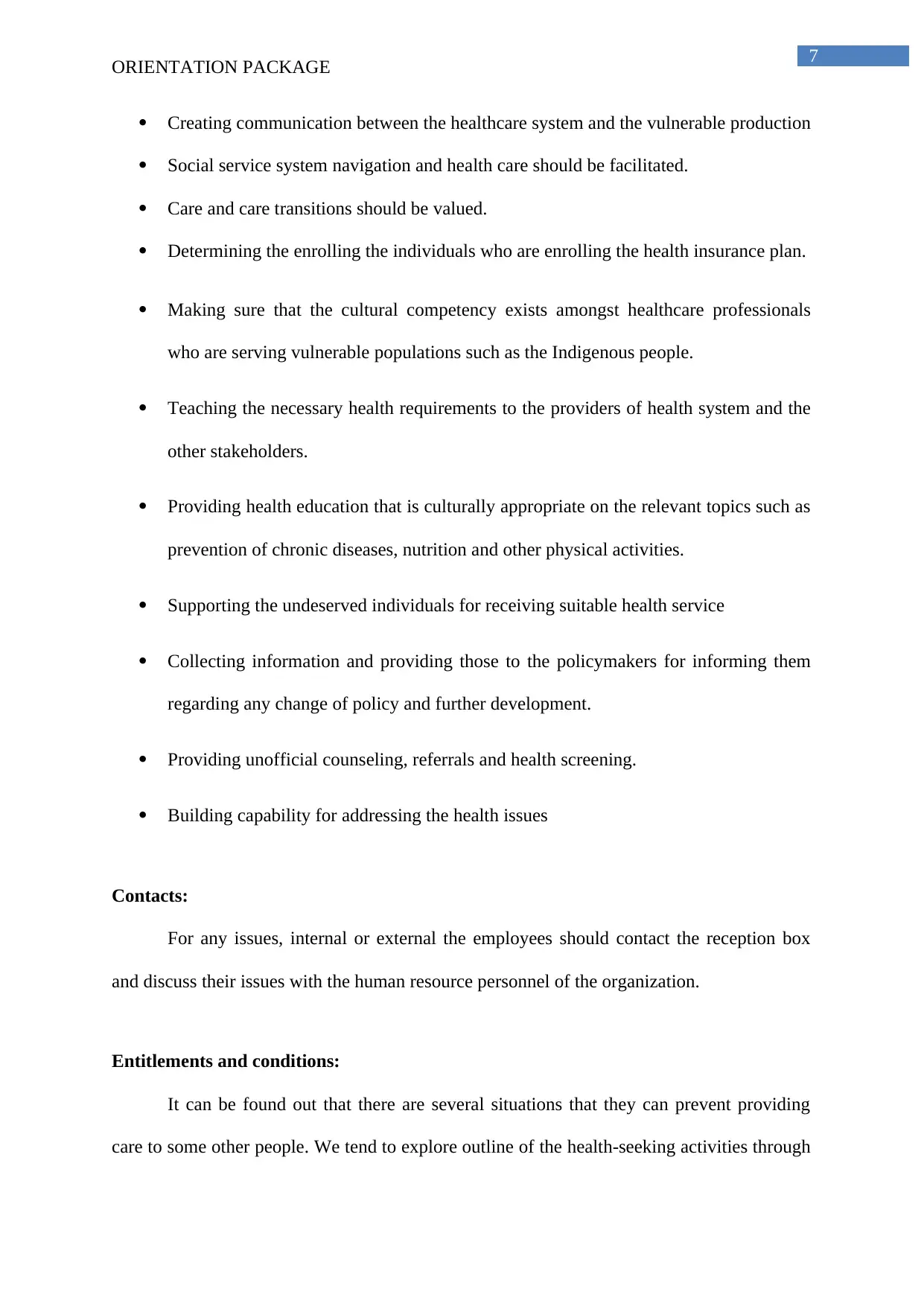
7
ORIENTATION PACKAGE
Creating communication between the healthcare system and the vulnerable production
Social service system navigation and health care should be facilitated.
Care and care transitions should be valued.
Determining the enrolling the individuals who are enrolling the health insurance plan.
Making sure that the cultural competency exists amongst healthcare professionals
who are serving vulnerable populations such as the Indigenous people.
Teaching the necessary health requirements to the providers of health system and the
other stakeholders.
Providing health education that is culturally appropriate on the relevant topics such as
prevention of chronic diseases, nutrition and other physical activities.
Supporting the undeserved individuals for receiving suitable health service
Collecting information and providing those to the policymakers for informing them
regarding any change of policy and further development.
Providing unofficial counseling, referrals and health screening.
Building capability for addressing the health issues
Contacts:
For any issues, internal or external the employees should contact the reception box
and discuss their issues with the human resource personnel of the organization.
Entitlements and conditions:
It can be found out that there are several situations that they can prevent providing
care to some other people. We tend to explore outline of the health-seeking activities through
ORIENTATION PACKAGE
Creating communication between the healthcare system and the vulnerable production
Social service system navigation and health care should be facilitated.
Care and care transitions should be valued.
Determining the enrolling the individuals who are enrolling the health insurance plan.
Making sure that the cultural competency exists amongst healthcare professionals
who are serving vulnerable populations such as the Indigenous people.
Teaching the necessary health requirements to the providers of health system and the
other stakeholders.
Providing health education that is culturally appropriate on the relevant topics such as
prevention of chronic diseases, nutrition and other physical activities.
Supporting the undeserved individuals for receiving suitable health service
Collecting information and providing those to the policymakers for informing them
regarding any change of policy and further development.
Providing unofficial counseling, referrals and health screening.
Building capability for addressing the health issues
Contacts:
For any issues, internal or external the employees should contact the reception box
and discuss their issues with the human resource personnel of the organization.
Entitlements and conditions:
It can be found out that there are several situations that they can prevent providing
care to some other people. We tend to explore outline of the health-seeking activities through
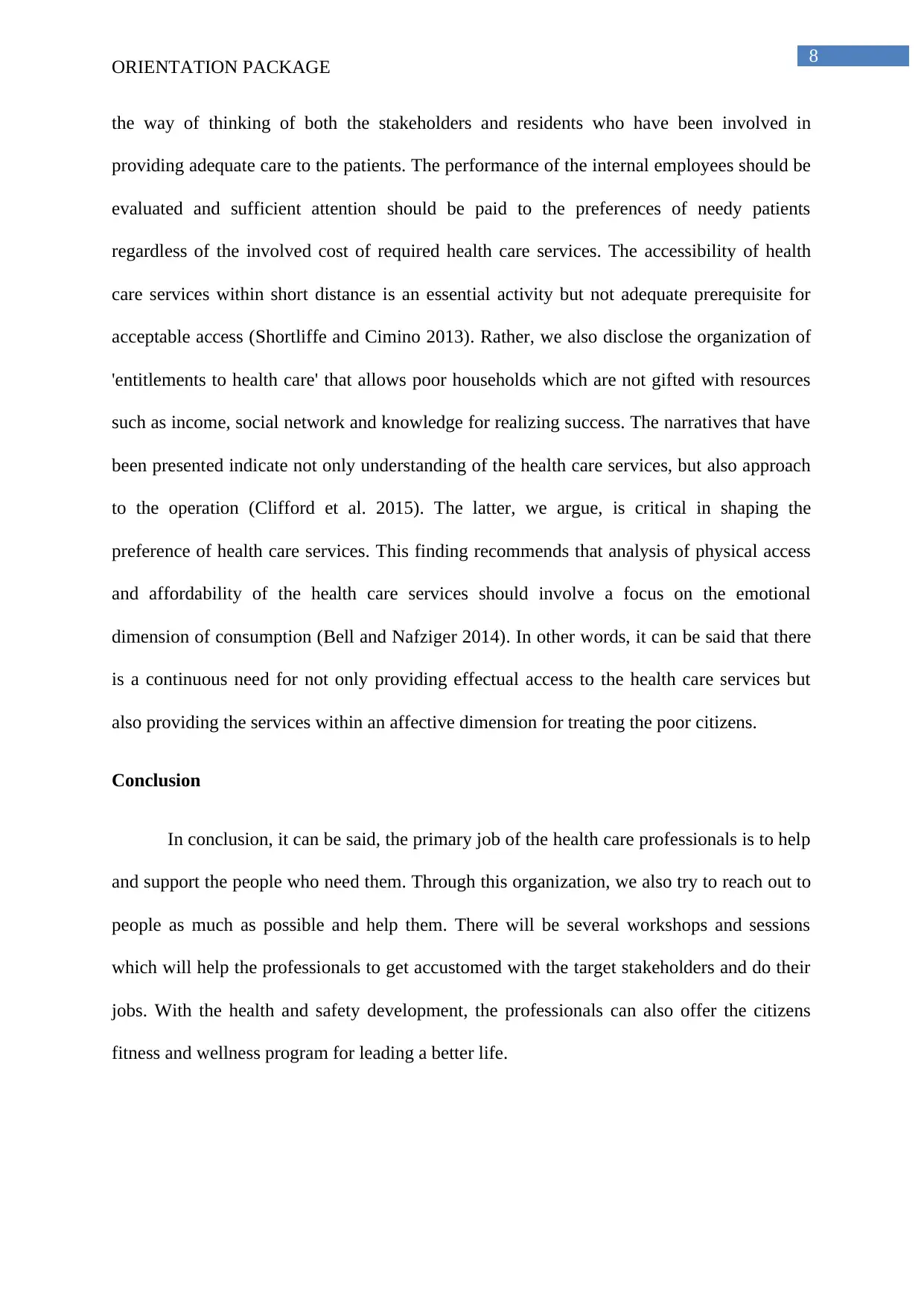
8
ORIENTATION PACKAGE
the way of thinking of both the stakeholders and residents who have been involved in
providing adequate care to the patients. The performance of the internal employees should be
evaluated and sufficient attention should be paid to the preferences of needy patients
regardless of the involved cost of required health care services. The accessibility of health
care services within short distance is an essential activity but not adequate prerequisite for
acceptable access (Shortliffe and Cimino 2013). Rather, we also disclose the organization of
'entitlements to health care' that allows poor households which are not gifted with resources
such as income, social network and knowledge for realizing success. The narratives that have
been presented indicate not only understanding of the health care services, but also approach
to the operation (Clifford et al. 2015). The latter, we argue, is critical in shaping the
preference of health care services. This finding recommends that analysis of physical access
and affordability of the health care services should involve a focus on the emotional
dimension of consumption (Bell and Nafziger 2014). In other words, it can be said that there
is a continuous need for not only providing effectual access to the health care services but
also providing the services within an affective dimension for treating the poor citizens.
Conclusion
In conclusion, it can be said, the primary job of the health care professionals is to help
and support the people who need them. Through this organization, we also try to reach out to
people as much as possible and help them. There will be several workshops and sessions
which will help the professionals to get accustomed with the target stakeholders and do their
jobs. With the health and safety development, the professionals can also offer the citizens
fitness and wellness program for leading a better life.
ORIENTATION PACKAGE
the way of thinking of both the stakeholders and residents who have been involved in
providing adequate care to the patients. The performance of the internal employees should be
evaluated and sufficient attention should be paid to the preferences of needy patients
regardless of the involved cost of required health care services. The accessibility of health
care services within short distance is an essential activity but not adequate prerequisite for
acceptable access (Shortliffe and Cimino 2013). Rather, we also disclose the organization of
'entitlements to health care' that allows poor households which are not gifted with resources
such as income, social network and knowledge for realizing success. The narratives that have
been presented indicate not only understanding of the health care services, but also approach
to the operation (Clifford et al. 2015). The latter, we argue, is critical in shaping the
preference of health care services. This finding recommends that analysis of physical access
and affordability of the health care services should involve a focus on the emotional
dimension of consumption (Bell and Nafziger 2014). In other words, it can be said that there
is a continuous need for not only providing effectual access to the health care services but
also providing the services within an affective dimension for treating the poor citizens.
Conclusion
In conclusion, it can be said, the primary job of the health care professionals is to help
and support the people who need them. Through this organization, we also try to reach out to
people as much as possible and help them. There will be several workshops and sessions
which will help the professionals to get accustomed with the target stakeholders and do their
jobs. With the health and safety development, the professionals can also offer the citizens
fitness and wellness program for leading a better life.
⊘ This is a preview!⊘
Do you want full access?
Subscribe today to unlock all pages.

Trusted by 1+ million students worldwide
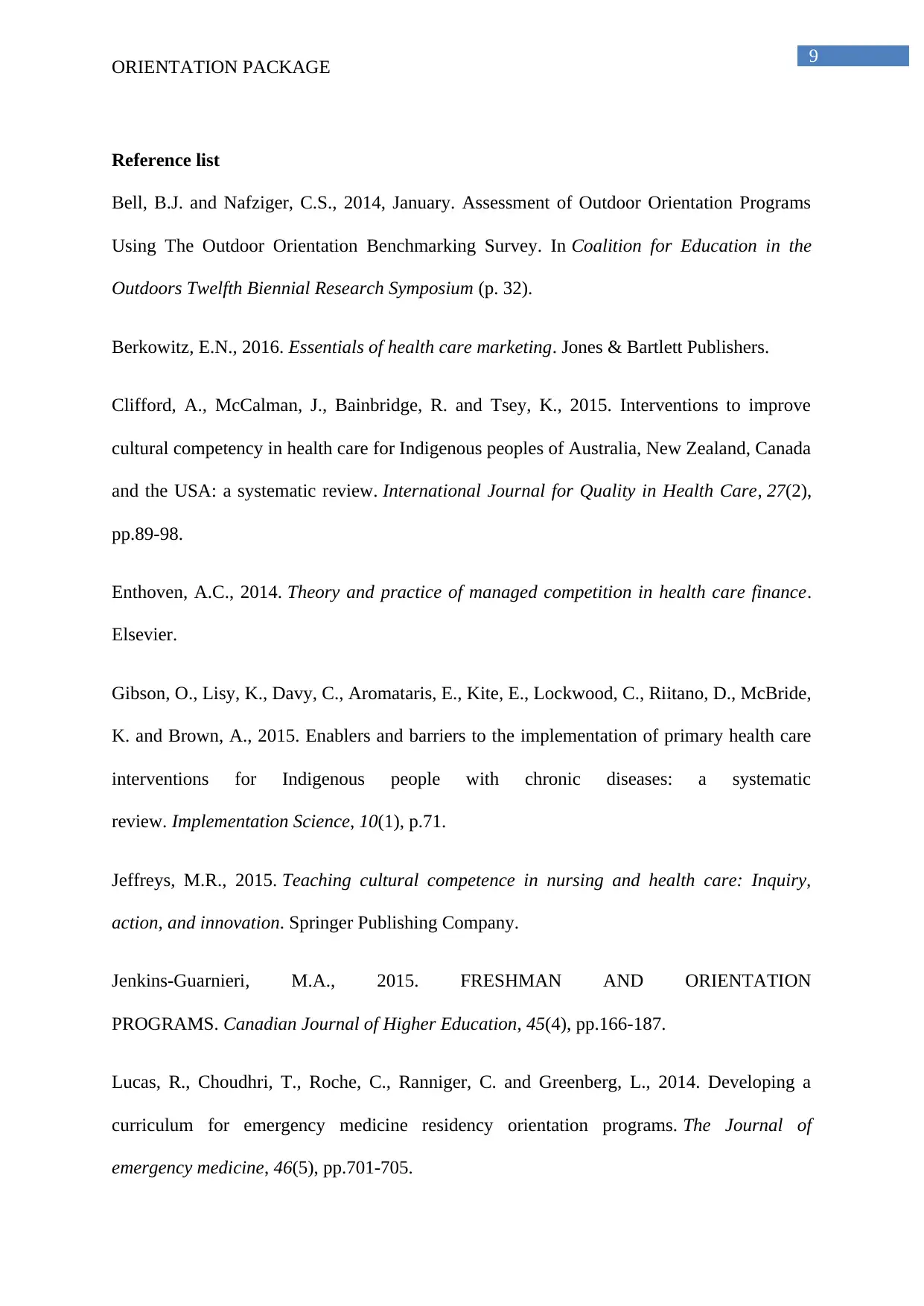
9
ORIENTATION PACKAGE
Reference list
Bell, B.J. and Nafziger, C.S., 2014, January. Assessment of Outdoor Orientation Programs
Using The Outdoor Orientation Benchmarking Survey. In Coalition for Education in the
Outdoors Twelfth Biennial Research Symposium (p. 32).
Berkowitz, E.N., 2016. Essentials of health care marketing. Jones & Bartlett Publishers.
Clifford, A., McCalman, J., Bainbridge, R. and Tsey, K., 2015. Interventions to improve
cultural competency in health care for Indigenous peoples of Australia, New Zealand, Canada
and the USA: a systematic review. International Journal for Quality in Health Care, 27(2),
pp.89-98.
Enthoven, A.C., 2014. Theory and practice of managed competition in health care finance.
Elsevier.
Gibson, O., Lisy, K., Davy, C., Aromataris, E., Kite, E., Lockwood, C., Riitano, D., McBride,
K. and Brown, A., 2015. Enablers and barriers to the implementation of primary health care
interventions for Indigenous people with chronic diseases: a systematic
review. Implementation Science, 10(1), p.71.
Jeffreys, M.R., 2015. Teaching cultural competence in nursing and health care: Inquiry,
action, and innovation. Springer Publishing Company.
Jenkins-Guarnieri, M.A., 2015. FRESHMAN AND ORIENTATION
PROGRAMS. Canadian Journal of Higher Education, 45(4), pp.166-187.
Lucas, R., Choudhri, T., Roche, C., Ranniger, C. and Greenberg, L., 2014. Developing a
curriculum for emergency medicine residency orientation programs. The Journal of
emergency medicine, 46(5), pp.701-705.
ORIENTATION PACKAGE
Reference list
Bell, B.J. and Nafziger, C.S., 2014, January. Assessment of Outdoor Orientation Programs
Using The Outdoor Orientation Benchmarking Survey. In Coalition for Education in the
Outdoors Twelfth Biennial Research Symposium (p. 32).
Berkowitz, E.N., 2016. Essentials of health care marketing. Jones & Bartlett Publishers.
Clifford, A., McCalman, J., Bainbridge, R. and Tsey, K., 2015. Interventions to improve
cultural competency in health care for Indigenous peoples of Australia, New Zealand, Canada
and the USA: a systematic review. International Journal for Quality in Health Care, 27(2),
pp.89-98.
Enthoven, A.C., 2014. Theory and practice of managed competition in health care finance.
Elsevier.
Gibson, O., Lisy, K., Davy, C., Aromataris, E., Kite, E., Lockwood, C., Riitano, D., McBride,
K. and Brown, A., 2015. Enablers and barriers to the implementation of primary health care
interventions for Indigenous people with chronic diseases: a systematic
review. Implementation Science, 10(1), p.71.
Jeffreys, M.R., 2015. Teaching cultural competence in nursing and health care: Inquiry,
action, and innovation. Springer Publishing Company.
Jenkins-Guarnieri, M.A., 2015. FRESHMAN AND ORIENTATION
PROGRAMS. Canadian Journal of Higher Education, 45(4), pp.166-187.
Lucas, R., Choudhri, T., Roche, C., Ranniger, C. and Greenberg, L., 2014. Developing a
curriculum for emergency medicine residency orientation programs. The Journal of
emergency medicine, 46(5), pp.701-705.
Paraphrase This Document
Need a fresh take? Get an instant paraphrase of this document with our AI Paraphraser
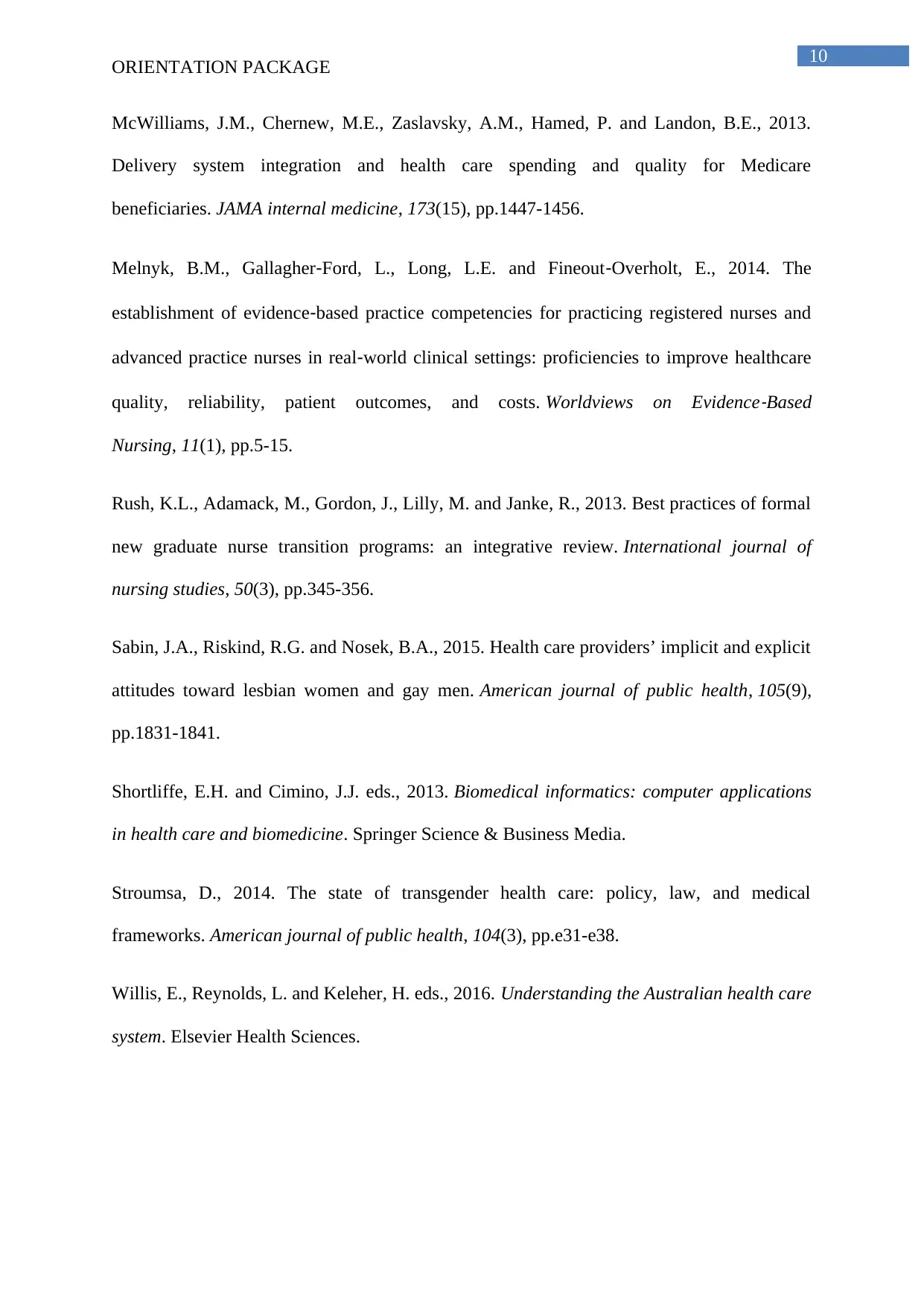
10
ORIENTATION PACKAGE
McWilliams, J.M., Chernew, M.E., Zaslavsky, A.M., Hamed, P. and Landon, B.E., 2013.
Delivery system integration and health care spending and quality for Medicare
beneficiaries. JAMA internal medicine, 173(15), pp.1447-1456.
Melnyk, B.M., Gallagher‐Ford, L., Long, L.E. and Fineout‐Overholt, E., 2014. The
establishment of evidence‐based practice competencies for practicing registered nurses and
advanced practice nurses in real‐world clinical settings: proficiencies to improve healthcare
quality, reliability, patient outcomes, and costs. Worldviews on Evidence
‐Based
Nursing, 11(1), pp.5-15.
Rush, K.L., Adamack, M., Gordon, J., Lilly, M. and Janke, R., 2013. Best practices of formal
new graduate nurse transition programs: an integrative review. International journal of
nursing studies, 50(3), pp.345-356.
Sabin, J.A., Riskind, R.G. and Nosek, B.A., 2015. Health care providers’ implicit and explicit
attitudes toward lesbian women and gay men. American journal of public health, 105(9),
pp.1831-1841.
Shortliffe, E.H. and Cimino, J.J. eds., 2013. Biomedical informatics: computer applications
in health care and biomedicine. Springer Science & Business Media.
Stroumsa, D., 2014. The state of transgender health care: policy, law, and medical
frameworks. American journal of public health, 104(3), pp.e31-e38.
Willis, E., Reynolds, L. and Keleher, H. eds., 2016. Understanding the Australian health care
system. Elsevier Health Sciences.
ORIENTATION PACKAGE
McWilliams, J.M., Chernew, M.E., Zaslavsky, A.M., Hamed, P. and Landon, B.E., 2013.
Delivery system integration and health care spending and quality for Medicare
beneficiaries. JAMA internal medicine, 173(15), pp.1447-1456.
Melnyk, B.M., Gallagher‐Ford, L., Long, L.E. and Fineout‐Overholt, E., 2014. The
establishment of evidence‐based practice competencies for practicing registered nurses and
advanced practice nurses in real‐world clinical settings: proficiencies to improve healthcare
quality, reliability, patient outcomes, and costs. Worldviews on Evidence
‐Based
Nursing, 11(1), pp.5-15.
Rush, K.L., Adamack, M., Gordon, J., Lilly, M. and Janke, R., 2013. Best practices of formal
new graduate nurse transition programs: an integrative review. International journal of
nursing studies, 50(3), pp.345-356.
Sabin, J.A., Riskind, R.G. and Nosek, B.A., 2015. Health care providers’ implicit and explicit
attitudes toward lesbian women and gay men. American journal of public health, 105(9),
pp.1831-1841.
Shortliffe, E.H. and Cimino, J.J. eds., 2013. Biomedical informatics: computer applications
in health care and biomedicine. Springer Science & Business Media.
Stroumsa, D., 2014. The state of transgender health care: policy, law, and medical
frameworks. American journal of public health, 104(3), pp.e31-e38.
Willis, E., Reynolds, L. and Keleher, H. eds., 2016. Understanding the Australian health care
system. Elsevier Health Sciences.
1 out of 11
Related Documents
Your All-in-One AI-Powered Toolkit for Academic Success.
+13062052269
info@desklib.com
Available 24*7 on WhatsApp / Email
![[object Object]](/_next/static/media/star-bottom.7253800d.svg)
Unlock your academic potential
Copyright © 2020–2025 A2Z Services. All Rights Reserved. Developed and managed by ZUCOL.





